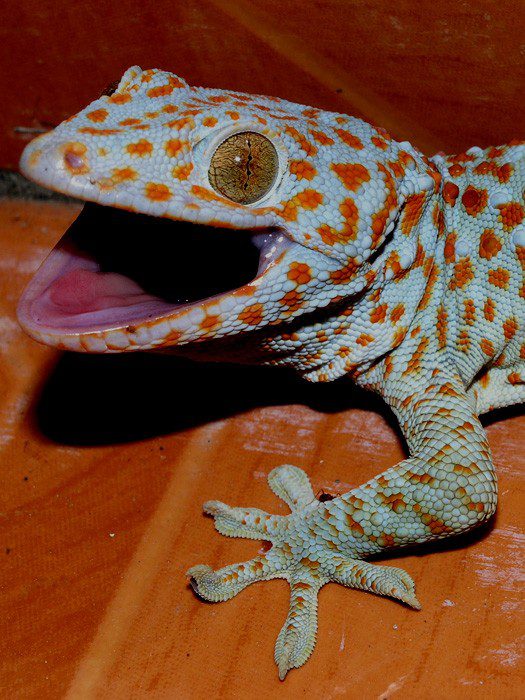
Gecko Toki
Every person, even a child, has heard of geckos at least once. Yes, at least about their ability to run on the ceiling! And recently, many people fly to rest in Thailand, Malaysia, Indonesia, India, Vietnam, and other countries in Southeast Asia. This territory is the birthplace of Toki geckos, where it is quite easy to meet them, or rather, they themselves often visit people’s houses, where they feast on insects that flock to the light. What is there to see, you can even hear them! Yes, yes, this lizard has a voice (rather rare in reptiles). In the evening and at night, male geckos, replacing birds, fill the air with loud cries, somewhat reminiscent of croaking and periodic cries of “to-ki” (which, translated from the gecko language, means that the territory is already occupied, he does not wait for strangers, unless that the female will be happy). From here, as you know, this lizard got its name.
The Toki geckos won the attention of terrariumists due to their interesting appearance, bright color, unpretentiousness and good fertility. Now they are actively bred in captivity. Basically, the body is painted in a gray-blue color, on which there are orange, white, reddish-brown spots. Males are larger and brighter than females. In length, geckos can grow up to 25-30 and even up to 35 cm.
The large eyes of these reptiles are also interesting, the pupil in them is vertical, completely narrowed in the light, and expanding in the dark. There are no moving eyelids, and at the same time, geckos periodically wash their eyes, licking with a long tongue.
They are really able to run on absolutely flat vertical surfaces (such as polished stones, glass) thanks to microscopic hook hairs on the “soles” of their legs.
For keeping them in captivity, a vertical terrarium is suitable (approximately 40x40x60 per individual). In nature, these are strictly territorial animals, so keeping two males is very dangerous. A group can keep one male with several females.
It is better to decorate the vertical walls of the terrarium with bark, on which they will run. Inside there should be a large number of branches, snags, plants and shelters. Shelters are needed for the rest of these nocturnal animals during the daytime. Branches and plants should be strong enough to support the weight of the reptile. Ficus, monstera, bromeliads are well suited as living plants. In addition to the aesthetic and climbing function, living plants also contribute to maintaining high air humidity. Since these animals come from tropical forests, the humidity should be maintained at a level of about 70-80%. To do this, you need to regularly spray the terrarium, and choose a moisture-retaining substrate, such as fine tree bark, coconut flakes, or sphagnum moss, as the soil. In addition, geckos most often use water as a drink, after spraying, licking it from leaves and walls.
It is also important to maintain optimal temperature conditions. In geckos, like other reptiles, food digestion, metabolism depends on body heating from external heat sources.
During the day, the temperature should stay at the level of 27-32 degrees, in the warmest corner it can rise up to 40 ºC. But at the same time, the heat source should be out of reach for the gecko, at some distance (if it is a lamp, then it should be 25-30 cm to the nearest point where the gecko can be) so as not to cause a burn. At night, the temperature can drop to 20-25 degrees.
An UV lamp is not required for nocturnal reptiles. But for reinsurance against rickets and if there are live plants in the terrarium, you can put a lamp with a UVB level of 2.0 or 5.0.
In nature, geckos eat insects, but they can also eat bird eggs, small rodents, chicks, and lizards. At home, crickets will be the best choice as the main diet, you can also give cockroaches, a zoophobus and occasionally indulge in newborn mice. But it is necessary to add vitamin and mineral supplements for reptiles containing calcium, vitamins, especially A and D3, to the diet. Top dressings are mainly in the form of a powder, in which the food collapses before giving it.
But there are some difficulties in keeping these animals. The first is associated with powerful jaws with a number of sharp small teeth, which are combined with a fairly aggressive character. They, like pit bulls, can grab onto the finger of an obsessive or sloppy guest and not let go for a very long time. Their bites are painful and can cause injury. Therefore, they should be taken, if necessary, from the side of the back, fixing the head with the fingers in the neck area. The second difficulty is their delicate skin (the opposite of their rough disposition), which, if handled and fixed ineptly, can easily be injured, along with this, they can drop their tail. The tail will recover, but will be somewhat paler than before and less beautiful.
It is necessary to carefully monitor the molting of the pet, with insufficient humidity or other errors in keeping, health problems, the lizards do not molt completely, but in “pieces”. The old, not separated skin must be soaked and carefully removed and, of course, figured out what led to such a violation.
So, to keep the Toki gecko, you need:
- Spacious vertical terrarium with lots of branches, plants and shelters.
- Soil – coconut, sphagnum.
- Humidity 70-80%.
- The temperature during the day is 27-32 degrees, at night 20-25.
- Regular spraying.
- Food: crickets, cockroaches.
- Vitamin and mineral supplements for reptiles.
- Keeping alone or in groups of a male and several females.
- Attentiveness, accuracy when dealing with animals.
You can not:
- Keep several males together.
- Keep in a tight terrarium, without shelters and branches.
- Do not observe temperature and humidity conditions.
- Feed plant foods.
- It is careless to grab a gecko, putting your health and that of the lizard in danger.





